

These home game consoles are displayed, and in some cases, available for
play in VIDEOTOPIA. All photographs on this page are taken from VIDEOTOPIA,
and are copyright 1997, 1998, Electronics Conservancy.
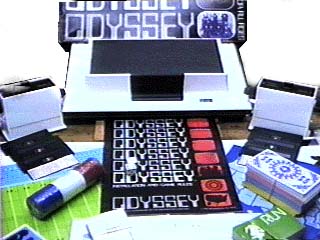 Magnavox Odyssey - 1972. Designed by Ralph Baer in 1966 and assisted by
Bill Harrison and Bill Rusch of Sanders Associates, a military electronics
firm. The Odyssey was introduced on January 27, 1972 at a price of $100.
Because microchips were so expensive, the Odyssey was designed using only 40
transistors and 40 diodes. This allowed the unit to generate only very
simple on-screen effects. To make the games more interesting, the Odyssey was
packaged with several plastic overlays to be placed on the TV screen to
simulate complex graphics. Players had to keep score themselves because the
machine was incapable of doing so. The unit was packaged with its screen
overlays, two controllers, six game cards, play money, playing cards, a
roulette and football playfield, a fold-out scoreboard, poker chips and a pair
of dice.
Magnavox Odyssey - 1972. Designed by Ralph Baer in 1966 and assisted by
Bill Harrison and Bill Rusch of Sanders Associates, a military electronics
firm. The Odyssey was introduced on January 27, 1972 at a price of $100.
Because microchips were so expensive, the Odyssey was designed using only 40
transistors and 40 diodes. This allowed the unit to generate only very
simple on-screen effects. To make the games more interesting, the Odyssey was
packaged with several plastic overlays to be placed on the TV screen to
simulate complex graphics. Players had to keep score themselves because the
machine was incapable of doing so. The unit was packaged with its screen
overlays, two controllers, six game cards, play money, playing cards, a
roulette and football playfield, a fold-out scoreboard, poker chips and a pair
of dice.
|
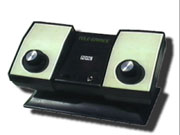
|
Atari PONG - 1975. Designed by Al Alcorn, Bob Brown, and Harold Lee.
Released under the Sears Telegames brand name, PONG went on sale at 900 Sears
stores across the country in January, 1975, and was the number one hit that
Christmas season. The machine gave Atari a reputation for quality home games
as well as arcade machines.
|
|
Fairchild Channel F - 1976.
Released in August 1976, Fairchild Camera and Instruments' Channel F system
refined the concept of the "programmable" videogame console. The appeal of
the system was that additional games could be purchased in the form of
"Videocart" cartridges.
|
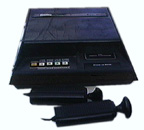
|

|
Atari Video Computer System (VCS) - 1977. Designed by: Joe Decure,
Harold Lee, and Steve Meyer. Better known as the Atari 2600, the Atari VCS
was the most popular videogame console of its day. Available until 1990, the
VCS was on the market longer than any other system in history. The VCS was
released in October 1977, at a retail price of $199.95. The heart of the
system was a 1.19 Mhz 8-bit Motorola 6507 microprocessor. The machine
contained 256 bytes of RAM to produce on-screen images.
|
|
Milton Bradley Microvision - 1979. Designed by Jay Smith.
The Microvision was first to combine the portability of handheld electronic
games with the programmability of systems like the Atari VCS. The base unit
contained a 2 inch square LCD screen and a dial control. The base unit itself
had no CPU. Each Microvision cartridge came with its own 4-bit
microprocessor.
|
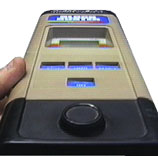
|
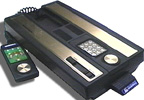
|
Mattel Electronics Intellivison - 1980. The graphics of the
Intellivision Master Component were a marvel compared to those of its main
competitor - the Atari VCS. However, the system traded speed for its
higher level of graphic detail. The Intellivison also featured innovative
add-ons like PlayCable, a 24-hour service that delivered games into the home
via cable-TV.
|
|
Coleco Colecovision - 1982.
When Coleco released the Colecovision in 1982 at $199.95, it was the system to
get. It contained 48K of RAM, the amount of memory available in most home
computers at that time. The Colecovision was driven by a 3.58 Mhz. 8-bit
Z-80A microprocessor. Coleco planned many "Expansion Modules" for the system.
One of these announced modules would turn the Colecovision into a home
computer. This module eventually became the ADAM computer system.
|

|
 Atari 5200 SuperSystem - 1982.
Atari released the Atari 400 and the Atari 800 computers. Both computers had
cartridge slots and built-in joystick ports. Although they were both
Atari 5200 SuperSystem - 1982.
Atari released the Atari 400 and the Atari 800 computers. Both computers had
cartridge slots and built-in joystick ports. Although they were both
 powerful computers, the 400 (pictured right) only had 16k of RAM and a membrane
keyboard which made typing difficult. The Atari 5200 (pictured left) was
basically an Atari 400 computer without the keyboard.
powerful computers, the 400 (pictured right) only had 16k of RAM and a membrane
keyboard which made typing difficult. The Atari 5200 (pictured left) was
basically an Atari 400 computer without the keyboard.
|
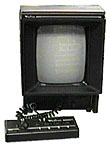
|
Milton Bradley/GCE Vectrex - 1982.
Designed by John Ross, Gerry Karr, John Hall and ex-Atari employees Paul
Newell and Mark Indictor from an idea by Jay Smith. The Vectrex was released
at a price of $199. It incorporated a 9 inch Vector graphic monitor and used
a Motorola 68A09 8-bit microprocessor. The original designers now hold the
rights to the machine and allow fans to copy and produce hardware and even new
software in gratitude for their loyalty to the system.
|
|
Nintendo Entertainment System (NES) - 1985. Designed by Masayuki
Uemura.
Nintendo released its Famicom (Family Computer) in late 1983. The system
featured an 8-bit 6502 microprocessor and a custom graphics chip that
produced 52 colors, while advanced previous systems had a maximum of 16. The
Famicom also contained far more RAM than any previous console. Nintendo
released the system in New York City during the Christmas season of 1985. The
Famicom, now called the NES, came with game controllers, a light-gun and
R.O.B. - the Robotic Operating Buddy.
|
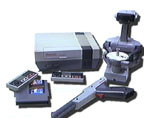
|

|
Nintendo Game Boy - 1989. Designed by Gumpei Yokoi and Nintendo R&D
Team #1. The Game Boy was a portable system that used a black and green LCD
screen and was programmable with its interchangeable cartridges. It contained
a 1.1 Mhz 8-bit Microprocessor and was released at a price of $100. Game Boy
was a huge success with adults as well as children.
|
|
NEC Turbografx-16 - 1989. Released in Japan in 1988 as the PC Engine,
the system was renamed the Turbografx-16 when it reached North America in
1989. Although NEC advertised the Turbografx-16 as a 16-bit game machine, it
actually had an 8-bit CPU. It did contain a separate 16-bit graphics chip
however. The Turbografx-16 became the first system to have a CD-player
attachment.
|
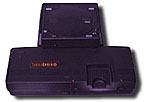
|

|
Atari Lynx - 1989.
After designing the advanced Commodore Amiga home computer, R.J. Mical and
Dave Needle decided to create the first color portable programmable game
system. Introduced at a price of $149, the Lynx's CPU was an 8-bit
microprocessor, and its screen was large and capable of displaying detailed
colorful images.
|
|
Sega Genesis - 1989.
Recognizing that great games sold systems, Sega took elements from its
16-bit arcade machines and produced the Mega-Drive in 1989. When the machine
reached American stores it was called the Genesis, and it retailed for $199.
Featuring a version of the Motorola 68000 16-bit microprocessor that had
powered the original Apple Macintosh, the new console was capable of running
excellent translations of Sega arcade hits.
|

|

|
3DO Interactive Multiplayer - 1993. Designed by R.J. Mical and Dave
Needle. 3DO was the first game system based only on CD technology. The
console could play VHS quality video, as well as CD quality sound. The 3DO
Company itself was also a change of pace. It did not build anything and
allowed other companies to make their own versions of the 3DO for a fee.
The Panasonic REAL FZ-1 3DO player used a 12.5 Mhz 32-bit microprocessor and
was released in late 1993 at a price of $699.95.
|
 Sega Saturn and Sony Playstation - 1995.
The Sony Playstation (pictured right) used a 33 Mhz 32-bit microprocessor
specifically designed to produce polygon graphics. The Playstation began its
Sega Saturn and Sony Playstation - 1995.
The Sony Playstation (pictured right) used a 33 Mhz 32-bit microprocessor
specifically designed to produce polygon graphics. The Playstation began its
 life as a CD attachment for the Super NES. When Sony and Nintendo disagreed
on the way the new device would be marketed, Sony decided to further develop
the Playstation into a game machine of its own.
life as a CD attachment for the Super NES. When Sony and Nintendo disagreed
on the way the new device would be marketed, Sony decided to further develop
the Playstation into a game machine of its own.
Sega used twin 28.8 Mhz 32-bit microprocessors and parallel processing to
power its Saturn system (pictured left). Like the Genesis, the Saturn
benefited from translations of Sega arcade games to help drive its popularity.
|
|
Nintendo Virtual Boy - 1995. Designed by Gumpei Yokoi.
Powered by a 10 Mhz 32-bit microprocessor and using a display system developed
by a Massachusetts company named Reflection Technologies, the Virtual Boy
displayed objects that seemed to actually exist in 3-Dimensions. Images were
produced on 2 tiny mirrored screens, one for each eye, in two colors - red and
black. Virtual Boy was priced at $179.99 when released.
|
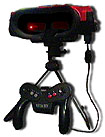
|

|
Nintendo 64 - 1996.
Packing the power of a 1980s supercomputer into a $150 game machine, the
Nintendo 64 used a 93.75 Mhz 64-bit microprocessor as it's CPU. The Nintendo
64 was jointly designed by Nintendo and Silicon Graphics. The system's
controller itself was revolutionary, designed specifically for control of
the 3-D games that had become so popular. The Nintendo 64, as well as the
32-bit machines from Sega and Sony, out-powered the personal computers in
terms of game playing and exposed players to worlds of entertainment
previously unimaginable.
|
Each home console exhibit in VIDEOTOPIA offers at least 3 times more
information than what is presented for each console here!

VIDEOTOPIA and Electronics Conservancy are registered
trademarks of The Electronics Conservancy, Inc. All rights reserved. All
photos (c)1997, 1998 Electronics Conservancy. All videogames, characters,
brand names, and trademarks are the properties of their respective owners.


 Magnavox Odyssey - 1972. Designed by Ralph Baer in 1966 and assisted by
Bill Harrison and Bill Rusch of Sanders Associates, a military electronics
firm. The Odyssey was introduced on January 27, 1972 at a price of $100.
Because microchips were so expensive, the Odyssey was designed using only 40
transistors and 40 diodes. This allowed the unit to generate only very
simple on-screen effects. To make the games more interesting, the Odyssey was
packaged with several plastic overlays to be placed on the TV screen to
simulate complex graphics. Players had to keep score themselves because the
machine was incapable of doing so. The unit was packaged with its screen
overlays, two controllers, six game cards, play money, playing cards, a
roulette and football playfield, a fold-out scoreboard, poker chips and a pair
of dice.
Magnavox Odyssey - 1972. Designed by Ralph Baer in 1966 and assisted by
Bill Harrison and Bill Rusch of Sanders Associates, a military electronics
firm. The Odyssey was introduced on January 27, 1972 at a price of $100.
Because microchips were so expensive, the Odyssey was designed using only 40
transistors and 40 diodes. This allowed the unit to generate only very
simple on-screen effects. To make the games more interesting, the Odyssey was
packaged with several plastic overlays to be placed on the TV screen to
simulate complex graphics. Players had to keep score themselves because the
machine was incapable of doing so. The unit was packaged with its screen
overlays, two controllers, six game cards, play money, playing cards, a
roulette and football playfield, a fold-out scoreboard, poker chips and a pair
of dice.






 Atari 5200 SuperSystem - 1982.
Atari released the Atari 400 and the Atari 800 computers. Both computers had
cartridge slots and built-in joystick ports. Although they were both
Atari 5200 SuperSystem - 1982.
Atari released the Atari 400 and the Atari 800 computers. Both computers had
cartridge slots and built-in joystick ports. Although they were both
 powerful computers, the 400 (pictured right) only had 16k of RAM and a membrane
keyboard which made typing difficult. The Atari 5200 (pictured left) was
basically an Atari 400 computer without the keyboard.
powerful computers, the 400 (pictured right) only had 16k of RAM and a membrane
keyboard which made typing difficult. The Atari 5200 (pictured left) was
basically an Atari 400 computer without the keyboard.







 Sega Saturn and Sony Playstation - 1995.
The Sony Playstation (pictured right) used a 33 Mhz 32-bit microprocessor
specifically designed to produce polygon graphics. The Playstation began its
Sega Saturn and Sony Playstation - 1995.
The Sony Playstation (pictured right) used a 33 Mhz 32-bit microprocessor
specifically designed to produce polygon graphics. The Playstation began its
 life as a CD attachment for the Super NES. When Sony and Nintendo disagreed
on the way the new device would be marketed, Sony decided to further develop
the Playstation into a game machine of its own.
life as a CD attachment for the Super NES. When Sony and Nintendo disagreed
on the way the new device would be marketed, Sony decided to further develop
the Playstation into a game machine of its own.
